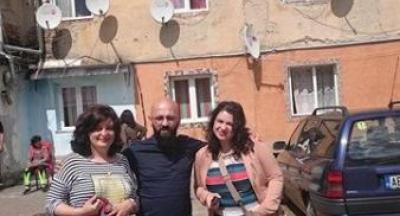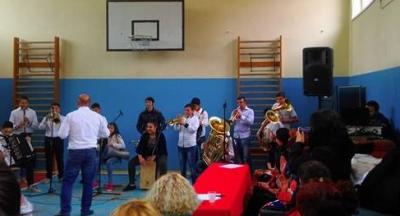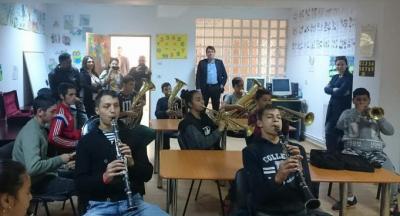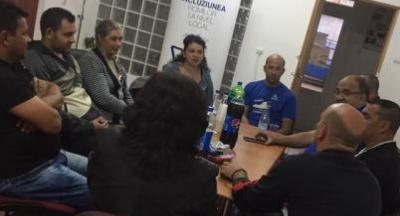Cugir
*Disclaimer: The information and views set out in this page do not necessarily reflect the official opinion of the Council of Europe and/or the European Commission. Neither the Council of Europe, the European Commission nor any person acting on their behalf may be held responsible for the use which may be made of the information contained therein.
Cugir is a Romanian town situated in the center of the country, about 40 kilometers south-west of Alba-Iulia (the capital City of Alba County). The town administers seven villages: Bocșitura (Potschitur), Bucuru (Bukur), Calene (Kalleney), Feteni (Fetzeberg), Goasele (Eisenhammer), Mugesti (Kudschirstallen) and Vinerea (Wolfsdorf). According to the 2011 census, the total population living in the town numbers 21.376 - 95.4% Romanians, 3.4% Roma, 0.9% Hungarians and 0.2% Germans.
There are 4 Roma communities in Cugir: Cosbuc neighborhood - the largest Roma community, including about 1.600 Roma inhabitants living in blocks of studio type, Raul Mic community – which numbers almost 400 Roma who live in small houses located under a hill, Rozelor street- includes almost 200 Roma who live in two blocks with low standard of living and Cindeni neighborhood – with approx. 100 Roma who live in regular houses.
The ROMACT Process
ROMACT process in Cugir started in February 2017. The Local Action Plan for Roma was adopted, under the ROMACT Programme, on 30 May 2017 and the Joint Action Plan became an annex to the Development Strategy of the Locality.
As of August 2023, ROMACT process is reinforced in Cugir and a new agreement was signed by the Mayor.
The Community Action Group (CAG) identified its short/medium/long-term needs:
| Short and mid-term priorities | Objective 1 | Objective 2 | Objective 3 |
|---|---|---|---|
| Education | Providing services for disinsection, disinfestation, current repairs in schools and kindergartens. | Organizing competitions, extracurricular activities and school camps for Roma children | |
| Culture | Organizing cultural events with specific/inspiration from Roma folklore and culture | Establishing a Roma Cultural Center | Organizing an annual event with the local Roma Fanfare |
| Health | Organizing health promotion/ anti-drug/ vaccination campaigns | Improving of gynecology-pediatrics section conditions at the local maternity |
| Long-term priorities | Objective 1 | Objective 2 | Objective 3 |
|---|---|---|---|
| Infrastructure | Repairing/asphalting the streets in the neighborhoods. Modernizing the public transport | Expansion of the electricity and water/sewage network | Arranging a collecting channel for rainwater and implementing a flood prevention system |
| Housing | Offering financial support and legal advice for people lacking identity and property documents | Rehabilitating the social houses | Arrangement of a leisure complex and skate park for children in the community |
| Employment | Supporting the process of developing competences for young people in the process of skills development and employment | Providing mentoring and support program to help Roma entrepreneurs create jobs and develop human capital in the community | Achieving a information, counseling, mediation process for a number of 1.000 Roma people |
| Education | Setting-up 2 school mediator positions | Ensuring a warm meal for Roma children going to school. Providing equipment, furniture, teaching materials in schools. | Develop "School after School" programs |
| Other | Modernizing the social canteen and setting up a shelter for homeless people | Setting up an Integrated Community Center and an information office for business ideas and non-reimbursable funds | Hiring one Roma local police officer |
The Municipality benefited of ROMACT expertise for the following projects :
The expertise provided by ROMACT for municipalities involves training and guidance on preparing project proposals and implementing inclusive policies aimed at improving the living conditions and social integration of vulnerable populations, including the Roma.
* Rehabilitation, modernization and equipment of Pervain School in Cugir - Funded by the Regional Operational Programme, P.A 13.
Budget : 1 533 524€
Status : approved
* Inclusion - European investment for social development in Cugir - Funded by OPHC 4.1.
Budget : 3 209 745€
Status : approved
Trainings provided by ROMACT experts :
- Local Authorities (LA):
- * Accessing EU funds
- * Developing of a project financed under ROP
- * Implementation of a project financed under OPHC 4.1
- * Accessing Structural and Cohesion Funds
Community Action Groups (CAG):
* Community development and civic participation
The following measures were taken to solve problems in Roma community:
* Rehabilitation of Block 15 and 8 Cosbuc neighbourhood
* Recruitment of a health mediator from Roma community
* Rehabilitation of the street lighting in Raul Mic community
* Construction of a wall to stop potential landslide





